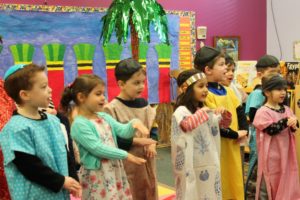 After a delightful morning watching JCDSRI kindergarteners theatrically reinterpret the Passover story and observing third graders refer to ancient Jewish texts as they create original (and delicious!) recipes for charoset, I return to my office. In the quiet, I reflect on the central role storytelling plays in our students experiences – and in defining and sustaining Jewish life. Stories are foundational to our learning at JCDSRI – and no more so than during our preparation for Passover. Beginning in Kindergarten, each of our students contributes to her/his personal Haggadah – the book that serves as a guide for our seder meals. The pages created by the children reflect the Haggadah’s demand that “in each generation, each person is obligated to see himself or herself [lirot et atzmo] as though he or she personally came forth from Egypt.”
After a delightful morning watching JCDSRI kindergarteners theatrically reinterpret the Passover story and observing third graders refer to ancient Jewish texts as they create original (and delicious!) recipes for charoset, I return to my office. In the quiet, I reflect on the central role storytelling plays in our students experiences – and in defining and sustaining Jewish life. Stories are foundational to our learning at JCDSRI – and no more so than during our preparation for Passover. Beginning in Kindergarten, each of our students contributes to her/his personal Haggadah – the book that serves as a guide for our seder meals. The pages created by the children reflect the Haggadah’s demand that “in each generation, each person is obligated to see himself or herself [lirot et atzmo] as though he or she personally came forth from Egypt.”
In retelling the story – in their own ways – our students imagine what once was and what might become. They are provided with a structure in which to place their hopes, fears, and dreams. Hannah Arendt reminds us that the power of storytelling lies in its capacity to “reveal meaning without committing the error of defining it.” In each retelling, we discover new understandings – as when one of our youngest students explains that Pharaoh was incapable of showing compassion to the Jewish people because he never personally experienced love. Or when a fifth grader thoughtfully considers the differences (and similarities) between physical and spiritual slavery – and the impact of injustice on people today.
Indeed, our rabbis have always insisted that halachah (Jewish law – with its defined path and structure) is incomplete without aggadah (literally “telling” or “story” – a form that is expansive, aspirational and imaginative ). As Rav A.J. Heschel wrote in Between God and Man, “aggadah deals with the whole of life . . . [it] introduces us to the realm that lies beyond the range of expression . . . and tells us how to participate in the eternal drama.” I am reminded that stories shape us as individuals and as a Jewish people.
We tell stories as an act of transformation. We tell our history in order to see ourselves in that time and place . . . and then to move beyond its limits. We use stories to make a difference in the world: to broaden our perspective, to embolden us to take actions previously unconsidered, and to expand our capacity to see, act and feel differently. The stories we tell help us to feel connected to those who lived many generations before us and also with those who will live many generation after us.
Stories have the capacity to bind us together. During this season of rebirth and renewal, I hope we all create the space and time to tell – and listen to – each other’s stories.
Andrea